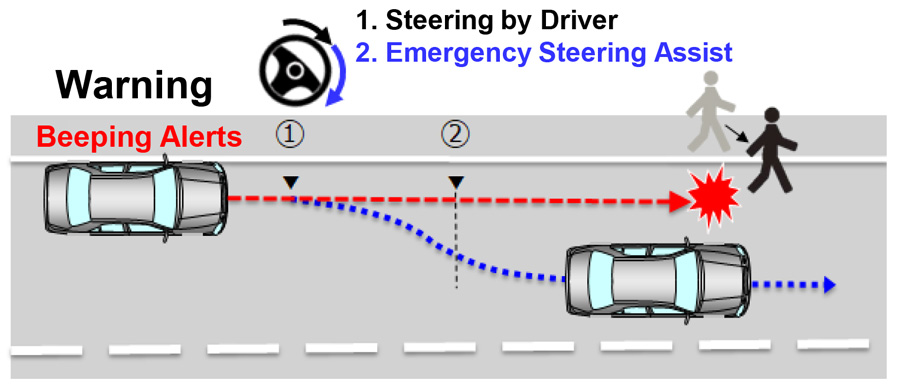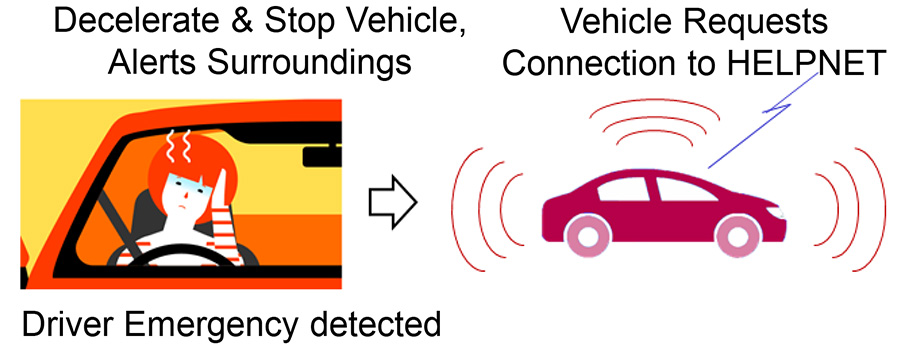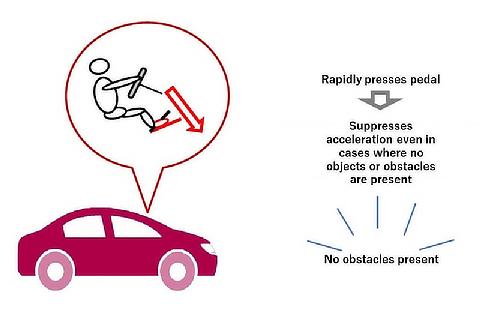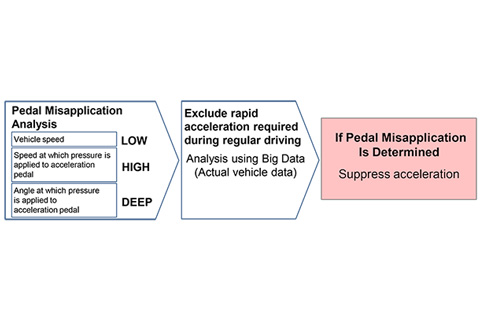Feb. 03, 2020
Toyota's New Acceleration Suppression Function Set to Launch in Summer 2020Big data from connected cars helps identify abnormal accelerator operation to control acceleration
Toyota City, Japan, February 3, 2020―Toyota Motor Corporation (Toyota) announced today that it has developed an Acceleration Suppression Function that used big data collected from connected cars to help identify abnormal operation of the accelerator and control acceleration. Toyota plans to install the function in new cars and introduce a new retrofit accelerator control system that will include the function for use with certain existing cars beginning gradually from this summer in Japan.
In its efforts to help deter serious accidents and reduce damage caused by misapplication of the accelerator, in 2012 Toyota introduced Intelligent Clearance Sonar (ICS). At present, 32 models,* or 83 percent of its line-up are, fitted with ICS. More recently, in 2018, Toyota launched a retrofit pedal misapplication acceleration control system for certain existing vehicles. The system can now be installed in 12 models, and 20,300 units have been fitted as of December 31, 2019. However, these devices and systems only work when sensors detect obstacles such as other cars or walls. Toyota's newly developed function aims to control acceleration due to abnormal operation of the accelerator even when no obstacles are present.
As Toyota was in the development phase, the company first looked at actual accidents where the cause was determined to be pedal misapplication, particularly analyzing situations where the accelerator pedal was pressed fully. The characteristics of these situations were then compared with big data collected from connected cars. By eliminating instances where it was determined that drivers were genuinely required to rapidly accelerate intentionally, such as when turning right or accelerating from a temporary stop, Toyota was able to identify and compute instances in which the accelerator was operated abnormally. In turn, this allowed for a function setting to control acceleration even in the absence of obstacles.
-

- Identifying abnormal accelerator operation and controlling acceleration in the absence of obstacles
By combining its existing ICS with the new Acceleration Suppression Function, Toyota believes it can further reduce the number of accidents caused by pedal misapplication in parking lots and other areas. Toyota also plans to share the operational logic of this function extensively, including with other auto makers.
The declining trend in the number of road traffic fatalities in Japan notwithstanding, more than 3,000 precious lives are still lost every year. Toyota intends to contribute to the elimination of traffic fatalities and injuries―the ultimate goal of a mobility society―using a three-pillar approach: 1) through improvements to car safety, via the implementation of this new function and the latest Toyota Safety Sense; 2) through educational initiatives to help inform people, such as the Support Toyota programs that promote further understanding of safety functions; and 3) through activities that seek to improve road traffic environments.
| * | Includes Toyota (26 models) and Lexus (6 models) |
|---|
Reference
- The history and evolution of Toyota Safety Sense
Toyota Safety Sense is a preventive safety package introduced in 2015. Using accident data from Japan, the United States, and Europe, it comprises three core functions that help avoid or mitigate damage and injury from serious traffic accidents: Pre-Collision System (PCS), Lane Departure Alert (LDA), and Automatic High Beam (AHB).
Toyota's goal is to completely eliminate traffic fatalities and injuries. To this end, Toyota has continued to develop Toyota Safety Sense since its introduction based on a two-pronged approach of further popularizing the package and of bolstering its adaptability to traffic accidents involving fatalities and injuries.
- By the end of 2017, Toyota had successfully equipped almost all passenger cars in Japan, the U.S., and Europe with Toyota Safety Sense.
- Toyota launched the second-generation Toyota Safety Sense in 2018. Due to the enhanced recognition capabilities of its sensors, this new generation is able to detect pedestrians at night, and cyclists crossing the street during the day. Toyota also strengthened the system's advanced driving support functions through the adoption of Lane Tracing Assist (LTA). The new Yaris, which goes on sale in February, will be equipped with a pre-collision safety system that additionally prevents collisions and reduces damage at intersections, by detecting oncoming cars when turning right, and by detecting oncoming pedestrians crossing the street when turning right or left.
With regard to further popularizing the package, at present a total of 4.3 million units in Japan, and a total of more than 16 million units in 108 countries and regions across the world, have been fitted with Toyota Safety Sense.
For further information on the launch and development of Toyota Safety Sense, please see this news release.
As far as bolstering its adaptability to traffic accidents involving fatalities and injuries, Toyota intends to further improve the system's functions. More specifically, several of the functions adopted in the Lexus Safety System +A, the advanced safety package that was equipped to the Lexus LS in 2017, will be added to Toyota Safety Sense.
- PCS (Emergency Steering Assist)
When it detects a pedestrian suddenly straying into the road, the function provides steering assist while ensuring the car remains within its lane to help avoid a collision.
- Driver Emergency Stop Assist
The system alerts the driver if it detects non-operation of the steering wheel, accelerator, or brakes due to a sudden change in the driver's physical condition; at the same time, it alerts nearby vehicles by sounding the horn and activating hazard lights, and gradually decelerates the car to a stop.
After stopping, the system automatically connects to HELPNET, in supporting the provision of emergency care as soon as possible.
- LTA and Dynamic Radar Cruise Control (with Curve Speed Reduction Function)
LTA combines AI technologies with camera-based white line recognition to provide a more stable and comfortable ride: it matches vehicle deceleration to the size of an approaching curve to ensure that sideways G-forces remain constant, and it also helps minimize interruptions during curves with small radii and inside tunnels.
Toyota intends to launch the new Toyota Safety Sense, which includes the functions listed above, this year.
- Toyota Teammate Advanced Park (including Panoramic View Monitor functions), Toyota's advanced parking support system
Advanced Park, Toyota's advanced parking support system, is available for the new Yaris. The system provides 360-degree monitoring around the car, detects parking spaces, controls steering, acceleration, and braking, and parks the car accurately, smoothly, and with peace of mind.
Due to its easy-to-understand interface and simple method of operation, the system is designed to appeal to all drivers, not just those who dislike parking. When the parking system is engaged, the driver is only required to shift gears; if, for any reason, the driver presses the accelerator, the car stops for peace of mind.












